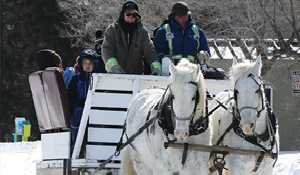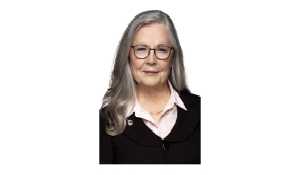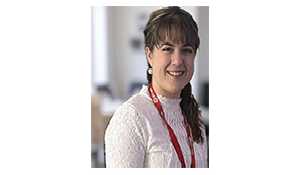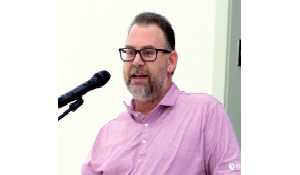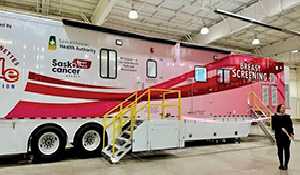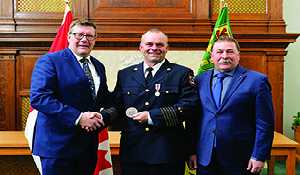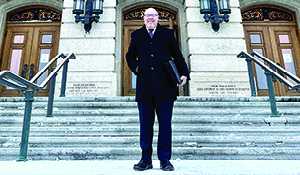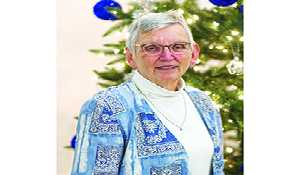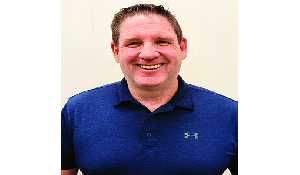Full-time programs may end at SERC Moosomin
February 3, 2015, 2:00 am
Julia Dima


Last week, the Southeast Regional College’s Moosomin Campus held an open house for its 20-week Electrician program. The full-time program, as well as the full-time office education program, may not be offered in Moosomin this fall.
The electrical program gives students the basics for electrical work and essentially amounts to the first year’s work of an electrical apprenticeship.
“This is the basics, to teach them the first year of apprenticeship. They learn mainly residential, light commercial work, all the basics to get them started—what the tools are, what the materials are, the basics to go out there and get a job as if they were a first year apprentice,” explains Dean Kazakoff, who has been the electrical instructor of the program for one year.
“Otherwise, normally an apprentice has to go out there, try to find a job, do hands-on learning for a year on the job, and then do eight weeks of school.” The electrical program was first offered in 2006, and it has room for 12 students. While the same program can have up to a three-year waiting list at SIAST in Moose Jaw, Saskatoon, or Prince Albert, Moosomin’s program typically has no waiting list.
Unlike larger programs, the electrical program in Moosomin has one instructor that teaches code, theory and practical application to students—for Kazakoff, he says he tries to teach all three in application with each other, so students are prepared for the hands-on application of electrical work in their first year of work.
His students say that works well. “One of the things I really like about this program is the hands-on training. It’s not just theory and hands-on separate, we do it together,” says Linda Fowell, who is nearly finished the 20-week program and ready to go into the work force.
Fowell says her father was an electrician, and as long as she can remember, she wanted to follow in his footsteps. Family life caught up to her, and she worked at Scotiabank in Moosomin for most of her life. Now, she says, her youngest child is 26 and she was ready to go back to school and pursue the dream she always had.
“I knew this program was available here, I wasn’t sure how it all worked, but I was going to do whatever it took to make my dream come true. I am glad it’s here, I like being local. It’s been an excellent program,” she says.
Dylan Mills grew up in Wawota, and says he wanted to do hands-on work after going to university for kinesiology. “Kinesiology was a lot of book work, and I wanted to do something hands-on,” he says. “Actually, Dean (Kazakoff) said that compared to SIAST in Moose Jaw, we’ve done more lab projects, which is surprising to me.”
Originally, Mills planned to attend the program at SIAST in Moose Jaw. Like so many others, he was put on a waiting list that he was told could be two to three years long.
“I was on the waiting list for probably five or six months, and this program showed up, so I applied and was accepted. I kept my holding spot at Moose Jaw to see if they would accept me, and if not, then I would stay here. That actually benefited me in the end—I have a home in Wawota, so I save money. Fuel and food are my only costs,” Mills says. “I have talked to people who would tell me, ‘oh you’re not going to get into Moose Jaw, you’ll be waiting, I’m still waiting.’ It seems like city people don’t want to come to college in a small town, but it actually benefits me to do that.”
Jasmine Logan is another student who benefited from having the program close to home. Logan grew up in Esterhazy, and after high school, was planning to take a year off.
“My dad found out about this program, and said, ‘you should apply for this, it’s what you wanted to do.’ So, I applied, I didn’t think I was going to get in because I applied pretty late, but four days before the program started, I got a phone call saying I was in. Actually, I’m happy I did this, because if I didn’t get in when I did, I don’t know if I would have gone back to school,” she says.
Many of the graduates from the program have landed employment in the local area. Some have even started their own electrical businesses.
Kyle Jeannot took the electrician program the first year it was offered in 2006. In 2007 after he finished, he worked at different electrical businesses including both Nixon’s and Grayson’s and on June 9, 2014, Jeannot started his own electrical company in Moosomin, Jeannot Electric. Starting his own company was a goal since he graduated from the electrical program at the college.
“As soon as I did this course, and was working in field, I wanted to have a business,” Jeannot says. “It felt good to get to that point, there was a sense of accomplishment, and it’s nice to be able to serve people in the community.”
Jeannot grew up in Whitewood, and planned to go to SIAST before he saw the program being offered closer to home. He has a small staff, just himself, his wife, and an apprentice, but Jeannot says he plans to expand, and at the open house, 11 students about to graduate the program shared the room with Jeannot.
“We want to hire someone soon, so we’re definitely going to take a look at the applicants coming out of here today, and hopefully one of them is eligible to get a job with us,” Jeannot says.
Despite the benefits the program has had for these graduates, the Electrician program, along with the Office Education program, may not be offered at the Moosomin Campus next year. This is because the funding allocation matrix used by Southeast Regional College looks at market labour needs across the region, and programs are put into a queue. The programs that have the most demand in the job market for the region are at the top of the queue. Those that are less popular region-wide are lower on the queue and less likely to receive funding for the next year.
“Every spring, we start our planning process for the next academic year, and in December, we present a recommendation for next year’s program planning from the pool of funds that we get from the provincial government. There is a finite pool of money to fund programming, so what we do is use a framework to help in the prioritization of our needs,” explains Southeast College CEO and President Dion McGrath. “We make recommendations based on assumptions of what we think we will have in terms of resources, based on labour market needs of our entire region—not just Moosomin, not just Estevan, the whole region. All of that is driven by labour market data—the better the data, the better the information, the higher it will score in our process of doing that.”
McGrath says this is the first of three stages in determining what programming will be offered in the next year. Next, he says, Southeast College will look for extra funding for programs that fall just below the funding queue, and wait for the provincial budget to be revealed, which will verify how much money is coming from the government for advanced education. The current projection is based on an assumed one per cent increase in projected funding.
“After the budget is known, we finalize everything, go back to the board and say, ‘this is our recommendation for the resources we have.’ They will enter a dialogue, and finally make ultimate decision. Then that business plan is submitted to the Minister of Advanced Education, who has to approve it,” McGrath explains.
Around 10 to 12 programs make it into the funding queue each year, and McGrath says some of the most popular programs across the region are heavy equipment truck and transport, power engineering, carpentry, hairstyling, Licensed Nurse Practitioner, Continuing Care Assistant, among a few. However, Electrician and Office Education in Moosomin are just below the top programs.
“If we can find added resources, these programs are going to be recommended,” McGrath says. “At the end of the day, we’re going to do everything we can to keep these programs in the queue and offer them going forward, but until we’re through the process and know the actual budget, we can’t confirm if they will or will not be here next year.”
As a potential employer of graduates, and a graduate of the program, Jeannot says he wants to see the program stay in Moosomin.
“We really hope it stays here, it’s great for the community, it creates apprentices for our electrical contractors here, and it helps the local economy out all around,” he says.
The students graduating from the program this year call the potential changes sad.
“I think it’s an awesome program. We were right full this year, the students came from all over the region, so it makes me sad that it might not be here” says Fowell. “The people who would come here for the program would rent homes and be part of the community, which is good for our economy. I think it should still be offered, absolutely.”
Mills and Logan say they both have friends who were planning on signing up for the program next year.
“We’ve been talking about the potential that the program will not be offered. It doesn’t really make too much sense to me,” Mills says.”I had a good friend that actually was ready to apply here, and when I told him they may not have the program, he was like, ‘Are you serious? I was going to apply.’ So, now he can’t do that.”
Logan says she has heard the same thing from classmates in Esterhazy.
“I know there are people from my high school interested, and just people I’ve talked to were planning on applying here for next year, because they don’t want to go to the city or be on a waiting list. Now they may not have a choice,” she says.
Kazakoff has already lined up a job teaching the Electrician program at Parkland College in Esterhazy, which starts in March. He says he is disappointed his first year teaching electrical in Moosomin will be his last.
“It’s nice that small community colleges offer these programs—not everyone wants to pack up and leave, and there are families too, if you have a family, you want to stay where they are, so you’re going to try to get your education where you live,” he says. “I think maybe they aren’t filling bigger institutions in the region, so they want to concentrate on sending them their instead of here, where the work is. For example, Estevan’s program has 4 in it, and we had 12.”
McGrath says he sees the benefit the program has in Moosomin, but the labour market assessment is region-wide, and that is how programs are allocated, regardless of specific campus demands.
He adds that if the electrical program does not make it into the course offerings for next year, it still has the potential to come back in future years.
“The labour market needs ebb and flow, so our courses will ebb and flow with those needs as they arise,” McGrath says.




